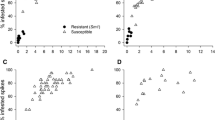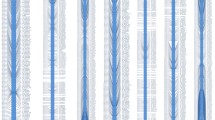Abstract
Toxicity due to high levels of soil boron (B) represents a significant limitation to cereal production in some regions, and the Bo1 gene provides a major source of B toxicity tolerance in bread wheat (Triticum aestivum L.). A novel approach was used to develop primers to amplify and sequence gene fragments specifically from the Bo1 region of the hexaploid wheat genome. Single-nucleotide polymorphisms (SNPs) identified were then used to generate markers close to Bo1 on the distal end of chromosome 7BL. In the 16 gene fragments totaling 19.6 kb, SNPs were observed between the two cultivars Cranbrook and Halberd at a low frequency (one every 613 bp). Furthermore, SNPs were distributed unevenly, being limited to only two genes. In contrast, RFLP provided a much greater number of genetic markers, with every tested gene identifying polymorphism. Bo1 previously known only as a QTL was located as a discrete Mendelian locus. In total, 28 new RFLP, PCR and SSR markers were added to the existing map. The 1.8 cM Bo1 interval of wheat corresponds to a 227 kb section of rice chromosome 6L encoding 21 predicted proteins with no homology to any known B transporters. The co-dominant PCR marker AWW5L7 co-segregated with Bo1 and was highly predictive of B tolerance status within a set of 94 Australian bread wheat cultivars and breeding lines. The markers and rice colinearity described here represent tools that will assist B tolerance breeding and the positional cloning of Bo1.



Similar content being viewed by others
References
Ayyadevara S, Thaden JJ, Reis RJS (2000) Discrimination of primer 3′-nucleotide mismatch by Taq DNA polymerase during polymerase chain reaction. Anal Biochem 284:11–18
Bossolini E, Krattinger SG, Keller B (2006) Development of simple sequence repeat markers specific for the Lr34 resistance region of wheat using sequence information from rice and Aegilops tauschii. Theor Appl Genet 113:1049–1062
Brunner S, Keller B, Feuillet C (2003) A large rearrangement involving genes and low-copy DNA interrupts the microcollinearity between rice and barley at the Rph7 locus. Genetics 164:673–683
Bryan GJ, Stephenson P, Collins A, Kirby J, Smith JB et al (1999) Low levels of DNA sequence variation among adapted genotypes of hexaploid wheat. Theor Appl Genet 99:192–198
Caldwell KS, Langridge P, Powell W (2004a) Comparative sequence analysis of the region harboring the hardness locus in barley and its colinear region in rice. Plant Physiol 136:3177–3190
Caldwell KS, Dvorak J, Lagudah ES, Akhunov E, Luo MC et al (2004b) Sequence polymorphism in polyploid wheat and their D-genome diploid ancestor. Genetics 167:941–947
Cartwright B, Zarcinas BA, Spouncer LR (1986) Boron toxicity in South Australian barley crops. Aust J Agric Res 37:351–359
Chalmers KJ, Campbell AW, Kretschmer J, Karakousis A, Henschke PH et al (2001) Construction of three linkage maps in bread wheat, Triticum aestivum. Aust J Agric Res 52:1089–1119
Chantachume Y, Smith D, Hollamby GJ, Paull JG, Rathjen AJ (1995) Screening for boron tolerance in wheat (Triticum aestivum L.) by solution culture in filter paper. Plant Soil 177:249–254
Collins NC, Thordal-Christensen H, Lipka V, Bau S, Kombrink E et al (2003) SNARE-protein-mediated disease resistance at the plant cell wall. Nature 425:973–977
Dvorak J, Luo MC, Yang ZL, Zhang HB (1998) The structure of the Aegilops tauschii gene pool and the evolution of hexaploid wheat. Theor Appl Genet 97:657–670
Eichler EE, Sankoff D (2003) Structural dynamics of eukaryotic chromosome evolution. Science 301:793–797
Erayman M, Sandhu D, Sidhu D, Dilbirligi M, Baenziger PS et al (2004) Demarcating the gene-rich regions of the wheat genome. Nucleic Acids Res 32:3546–3565
Hackauf B, Wehling P (2005) Approaching the self-incompatibility locus Z in rye (Secale cereale L.) via comparative genetics. Theor Appl Genet 110:832–845
Hayes JE, Reid RJ (2004) Boron tolerance in barley is mediated by efflux of B from the roots. Plant Physiol 136:3376–3382
Hossain KG, Kalavacharla V, Lazo GR, Hegstad J, Wentz MJ et al (2004) A chromosome bin map of 2148 expressed sequence tag loci of wheat homoeologous group 7. Genetics 168:687–699
Huang MM, Arnheim N, Goodman MF (1992) Extension of base mispairs by Taq DNA-Polymerase—implications for single nucleotide discrimination in PCR. Nucleic Acids Res 20:4567–4573
Jefferies SP, Barr AR, Karakousis A, Kretschmer JM, Manning S et al (1999) Mapping of chromosome regions conferring boron toxicity tolerance in barley (Hordeum vulgare L.). Theor Appl Genet 98:1293–1303
Jefferies SP, Pallotta MA, Paull JG, Karakousis A, Kretschmer JM et al (2000) Mapping and validation of chromosome regions conferring boron toxicity tolerance in wheat (Triticum aestivum L.). Theor Appl Genet 101:767–777
Kellis M, Patterson N, Endrizzi M, Birren B, Lander ES (2003) Sequencing and comparison of yeast species to identify genes and regulatory elements. Nature 423:241–254
Latorra D, Campbell K, Wolter A, Hurley JM (2003) Enhanced allele-specific PCR discrimination in SNP genotyping using 3′ locked nucleic acid (LNA™) primers. Hum Mutat 22:79–85
Li WL, Gill BS (2002) The colinearity of the Sh2/A1 orthologous region in rice, sorghum and maize is interrupted and accompanied by genome expansion in the triticeae. Genetics 160:1153–1162
Martin EM, Eastwood RF, Ogbonnaya FC, Emebiri L (2004) Molecular marker for the boron tolerance of the wheat cultivar Yanac. In: Proceedings of the 54th Australian cereal chemistry conference and 11th wheat breeders assembly, Canberra, pp 29–32
McIntosh RA, Hart GE, Devos KM, Gale MD, Rogers WJ (1998) Catalogue of gene symbols for wheat. In: Proceedings of the 9th international wheat genetics symposium, Saskatoon, Saskatchewan, University Extension Press, University of Saskatchewan, vol. 5
Mochida K, Yamazaki Y, Ogihara Y (2004) Discrimination of homoeologous gene expression in hexaploid wheat by SNP analysis of contigs grouped from a large number of expressed sequence tags. Mol Genet Genomics 270:371–377
Moody DB, Rathjen AJ, Cartwright B (1993) Yield evaluation of a gene for boron tolerance. In: Randall P, Delhaize E, Richards RA, Munns R (eds) Genetic aspects of plant mineral nutrition. Kluwer, Dordrecht, pp 363–366
Nable RO, Banuelos GS, Paull JG (1997) Boron toxicity. Plant Soil 193:181–198
Newton CR, Graham A, Heptinstall LE, Powell SJ, Summers C et al (1989) Analysis of any point mutation in DNA—the amplification refractory mutation system (ARMS). Nucleic Acids Res 17:2503–2516
Pallotta MA, Graham RD, Langridge P, Sparrow DHB, Barker SJ (2000) RFLP mapping of manganese efficiency in barley. Theor Appl Genet 101:1100–1108
Paull JG, Cartwright B, Rathjen AJ (1988) Responses of wheat and barley genotypes to toxic concentrations of soil boron. Euphytica 39:137–144
Paull JG, Nable RO, Rathjen AJ (1992) Physiological and genetic control of the tolerance of wheat to high concentrations of boron and implications for plant breeding. Plant Soil 146:251–260
Quarrie SA, Steed A, Calestani C, Semikhodskii A, Lebreton C et al (2005) A high-density genetic map of hexaploid wheat (Triticum aestivum L.) from the cross Chinese Spring X SQ1 and its use to compare QTLs for grain yield across a range of environments. Theor Appl Genet 110:865–880
R Development Core Team (2006). R: a language and environment for statistical computing. R foundation for statistical computing, Vienna, Austria. ISBN 3-900051-07-0, URL http://www.R-project.org
Rashid A, Ryan J (2004) Micronutrient constraints to crop production in soils with Mediterranean-type characteristics: a review. J Plant Nutr 27:959–975
Ravel C, Praud S, Murigneux A, Canaguier A, Sapet F et al (2006) Single-nucleotide polymorphism frequency in a set of selected lines of bread wheat (Triticum aestivum L.). Genome 49:1131–1139
Röder MS, Korzun V, Wendehake K, Plaschke J, Tixier MH et al (1998) A microsatellite map of wheat. Genetics 149:2007–2023
Rostoks N, Mudie S, Cardle L, Russell J, Ramsay L et al (2005) Genome-wide SNP discovery and linkage analysis in barley based on genes responsive to abiotic stress. Mol Genet Genomics 274:515–527
Russell J, Booth A, Fuller J, Harrower B, Hedley P et al (2004) A comparison of sequence-based polymorphism and haplotype content in transcribed and anonymous regions of the barley genome. Genome 47:389–398
Sears ER (1966) Chromosome mapping with the aid of telocentrics. In: MacKey J (ed) 2nd Wheat Genetics Symposium, Lund, pp 370–381
See DR, Brooks S, Nelson JC, Brown-Guedira G, Friebe B et al (2006) Gene evolution at the ends of wheat chromosomes. Proc Natl Acad Sci USA 103:4162–4167
Singh NK, Dalal V, Batra K, Singh BK, Chitra G et al (2007) Single-copy genes define a conserved order between rice and wheat for understanding differences caused by duplication, deletion, and transposition of genes. Funct Integr Genomics 7:17–35
Somers DJ, Kirkpatrick R, Moniwa M, Walsh A (2003) Mining single-nucleotide polymorphisms from hexaploid wheat ESTs. Genome 46:431–437
Spielmeyer W, Richards RA (2004) Comparative mapping of wheat chromosome 1AS which contains the tiller inhibition gene (tin) with rice chromosome 5S. Theor Appl Genet 109:1303–1310
Takano J, Noguchi K, Yasumori M, Kobayashi M, Gajdos Z et al (2002) Arabidopsis boron transporter for xylem loading. Nature 420:337–340
Takano J, Wada M, Ludewig U, Schaaf G, von Wiren N et al (2006) The Arabidopsis major intrinsic protein NIP5;1 is essential for efficient boron uptake and plant development under boron limitation. Plant Cell 18:1498–1509
Yau SK, Nachit M, Ryan J (1997) Variation in growth, development, and yield of durum wheat in response to high soil boron. 2. Differences between genotypes. Aust J Agric Res 48:951–957
Acknowledgments
The authors would like to thank K.T. Lawlor for excellent technical assistance, M. Pallotta for unpublished mapping data of SSRs, J.G. Paull for comments, P. Eckermann for statistical advice, and H. O’Sullivan for critical comments on previous versions of the manuscript. While conducting this research T. Schnurbusch was partly supported by a Research Fellowship, Feodor-Lynen-Program, from the Alexander-von-Humboldt Foundation, Bonn-Bad Godesberg, Germany, and partly by the Australian Centre for Plant Functional Genomics (ACPFG), Adelaide, Australia.
Author information
Authors and Affiliations
Corresponding author
Additional information
Communicated by B. Keller.
Electronic supplementary material
Below is the link to the electronic supplementary material.
Rights and permissions
About this article
Cite this article
Schnurbusch, T., Collins, N.C., Eastwood, R.F. et al. Fine mapping and targeted SNP survey using rice-wheat gene colinearity in the region of the Bo1 boron toxicity tolerance locus of bread wheat. Theor Appl Genet 115, 451–461 (2007). https://doi.org/10.1007/s00122-007-0579-0
Received:
Accepted:
Published:
Issue Date:
DOI: https://doi.org/10.1007/s00122-007-0579-0




